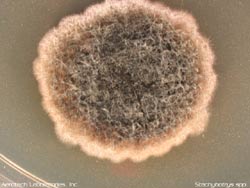mold
inspection
Scientific Mold Inspection
Background: Molds are an integral part of the world we live in, with
their spores literally everywhere. In the air we breathe, the food we
eat, the water we drink, the clothes we wear. Even the Bible speaks
of mold and its remediation. Life as we know it would not be possible
without mold, as molds are nature's garbage men. Without molds no decomposition
would be possible. The decomposed material then becomes nutrients for
new growth.
The organisms we call mold and mildew usually appear as black, gray
or green spots on roofs, walls, ceilings and floors are part of the
larger group known as 'fungi'. Mold growth requires two things, a moisture
source and nutrients. In our buildings, leaking pipes or a hole in the
roof provide the moisture, and wooden studs, carpet, drywall and flooring
provide the nutrients.
Within 24 to 48 hours, a single spore can blossom into a well developed
colony. Each spore contains all the genetic material to make a new colony.
With a little assistance from the air or from your clothes, these spores
can quickly spread to other locations. While traveling through the air
they are dormant, and chemical reactions in the spore are going on very
slowly. When a spore lands on a dry surface, it remains dormant and
will eventually die. Water, if present, is drawn into the spore by a
process known as osmosis.
Our concerns are threefold in our everyday indoor environment:
1. Mold exists naturally and is under control. Spore identification
and/or concentration is less than or equal to the immediate outdoor
environment.
2. Mold exists and is spreading due to excessive moisture. The indoor
environment is greater than 60% RH (Relative Humidity) and spore identification
and concentration is greater than the immediate outdoor environment.
3. Mold exists and is abundant enough to pose a health hazard for the
occupants of the property.
Back to OUR SERVICES

